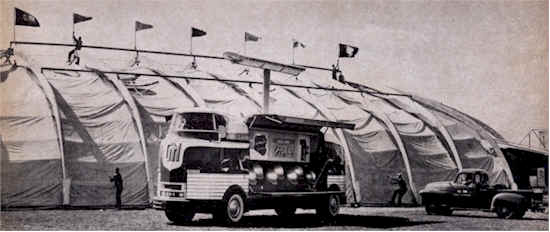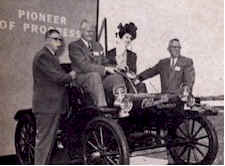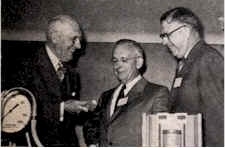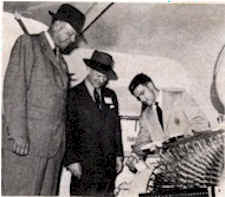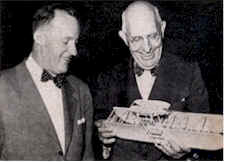|
This article was take from the June, 1953
issues of Automobile Topics, a Floyd Clymer Publication. The article
was written by John D. M. White
As General Motors staged at Dayton, Ohio, the world premiere of its
new Parade of Progress -- "a caravan of science", designed
to explain the meaning of research and better engineering to the
man-in-the-street, a GM executive predicted at America's opportunities
for further progress are greater now than ever before.
The later statement keynoted the remarks of Paul
Garrett, vice-president in charge of the GM public relations staff,
who 'emceed' on May 12 a noon press-radio-TV preview of the
big exhibition which has begun a cost-to-coast tour.
Previously, the non-commercial Parade had completed
'shake-down' shows at Frankfort and at Lexington, Kentucky,
initiating its tour to the accompaniment of what John E. Johnson,
consultant to the Parade, termed "frog-drowning" rains.
These persistent downpours made the young crews of lecturers and
drivers red-eyed with "round-the-clock" experience in tent
raising and de-bugging of exhibits, but apparently did not completely
dampen the ardor of the curious, for a gratifying attendance was
attracted.
Charles F. Kettering, of Dayton, famed inventory
and 'father' of the original Parade of Progress in 1936,
spoke on some of the scientific advances expected in the near future.
Now a GM director and research consultant, Mr. Kettering formerly
headed the company's research laboratories.
President Harlow H. Cutice could not be present,
due to other engagement and wired his greetings, but a battery of
other GM executives attended, including vice-presidents Charles I.
McCuen, general manager of the Research Laboratories Division, and
Charles A. Chayne, in charge of the engineering staff.
The evening was marked by an invitational civic
preview, held in the caravan's silver-colored Aerodome 'big
top', a special tent seating 1,250 people. Several hundred
educators, scientists, civic and industrial leaders and their families
attended.
Mr. Garrett, speaking at the preview in the
Aerodome, asserted: "Few people stop to realize just how dramatic
our progress has been. For example, it is difficult now to appreciate
what has happened to highway transportation within the memory of men
still living.
"The first horseless carriage made its debut
in this country not so very long ago, as we look back. Living in a
small town out west, I was 18 before I saw my first automobile. Yet
today, there are more than 50 million of them in America alone.
"And what this revolution has meant in terms
of jobs is even more amazing. Two generations ago highway
transportation was relatively unimportant as a source of employment in
this country. Today, one out of every seven workers owes his
livelihood, directly or indirectly, to the vehicles that roll on
highways.
"Through the Parade of Progress we hope to
bring home to people the fact of such change, of such increased
opportunities for jobs.
Outlining the aims of the Parade of Progress,
Garrett said:
"We think it would be worth a great deal to
all of us if there were a better understanding of why America has come
so far in the world and within so short a time.
"We also want our audiences to understand how
this progress has been achieved -- in other words, the role played by
science, by research, and by engineering -- backed up by an economic
and political system that over the long run has given people the
freedom to think, create and compete and has rewarded those who make
better products and help people live better."
Mankind in the old days was limited by the number
of men and animals that could be put to work," he pointed out, adding:
"Today, the only limit is the amount of power
that can be coaxed from machines. And the power potentialities of the
future are virtually unlimited.
"That is another point we want our audiences
to get: not only is the world definitely not finished, but opportunities
for further progress are greater now than ever before."
"To set a boy to dreaming," is another
major objective of the Parade, Garrett concluded:
"Because technological progress has been so
rapid over the past few years, with new discoveries opening up so many
new avenues of research, the available supply of young scientists and
engineers falls far short of the demand.
"If in the near future we don't get enough new
scientists and engineers to enable the demand to be met, our rate of
progress will lag. And so the Parade seeks to interest youth in making
a career in the technical progressions."
The initial Parade played before about 12-1/2
million people in 251 cities from 1936 to 1941, and was disbanded
after Pearl Harbor in 1941. The new Parade, now starting out, has been
rebuilt to show some of the outstanding advances in science in recent
years.
The Parade, operated by 55 young men, includes a 40-minute stage show
of science, presented six to eight times daily in the Aerodome. In
addition, the caravan features 26 major exhibits, displayed in a dozen
Futurliners. These are 33-foot long vans with 16-foot sides that open
to reveal the exhibits or to form small lecture stages.
Ten tractor-trailers, four other trucks, and 18 new
passenger cars complete the Parade, which moves from city to city, in
a three-mile procession at abut 35 mph. The vehicles maintain a separation
of 300 feet. The men of the Parade drive all the vehicles and give the
lectures, put on the science demonstration, and conduct the stage
show. Mechanics and a service trucks accompany the Parade.
In the stage show and the exhibits, which are free
to the public, the Parade dramatizes progress in such fields as
transportation, aviation, electronic, chemistry and power. Lecturers
operate some of the exhibits. Others are animated models with
synchronized sound. Several exhibits can be operated by visitors.
Preview guests at the tent show saw such scientific
advances as:
- A model jet engine, that operates with an
ear-splitting roar.
- A small microwave tower setup, such as used in
radar and TV, that "broadcasts" across the stage.
- A glass bottle so tough on the outside that a
lecturer uses it to hammer a spike through a plank; yet the bottle is
so weak on the inside that a pea-sized abrasive, dropped into a
bottle, smashes it to bits.
In brief, the Parade's purpose is to show basis
principles of science and what they mean to people -- at home and at
work.
GM spokesmen explained that in capsule form the
Parade displays products of modern engineering, research and science
that do not bear a General Motors trademark. Rather, they represent
engineering in a broad sense. They illustrate basic science principles
that both engineers and researchers deal with in their daily lives.
Vice-president McCuen has pointed out that, this
"newness" of these products lies in the application of the
principles, declaring: "It is virtually axiomatic that there is
nothing new in engineering.
"Almost every modern development can be traced
back either to some crude apparatus of an imaginative inventory or to
the recorded speculations of some scientists, philosophers or
observers -- men ahead of their times," he said.
"Other developments have sprung from
accidental discoveries of investigators searching for something far
removed from the objective they attempted to attain. But they
were keen enough to capitalize immediately on their un-expected
discoveries."
Pointing out that one of the featured exhibits is a
small motor -- a sun motor -- which converts into electricity enough
power from the sunlight to spin a light balsa wood wheel, McCuen said:
"It generates enough power actually to do
little more than illustrate a principle, the principle that sunlight
contains energy. Nature knew this before the beginning of time. All
our fuel in the form of coal, oil and natural gas is the result of
nature's method of storing energy in plants.
"Perhaps some day, either by accident or by
continuous, unrelenting research, an alert engineer or scientist will
discover the way to convert solar energy efficiently, directly from
the sun so we may use sun power for everyday utility purposes.
"When a commercially efficient method is
developed," he said, "it will have more far reaching effects
on civilization than any engineering development which has been made
up to this time.
The executive explained that the principle of jet
propulsion, dramatized with an Allison turbojet cutaway exhibit, harks
back to 130 B.C. That was when Hero of Alexandria, Egypt, built a
device to move symbolic figures on an altar.
Centuries later came the 'smoke jack,' a
windmill device in a chimney. Hot gases rising from the chimney base
or hearth caused it to rotate. The rotational power was used for such
tasks as turning the spit over a fire.
The crude predecessor of the gas turbine engine or
turbojet is the 'smoke jack.' The draft effect of the chimney
is reproached by an air compressor, the chimney hearth by a burner or
combustion chamber and the 'smoke jack' by a turbine wheel.
From Mr. McCuen and his aides at the laboratories
come other interesting examples of the growth of science in our modern
living.
In discussion about automobiles these days, the
term 'high compression' is part of the language. More than
65 years ago an Englishman, Dugald Clerk, observed that by raising
compression ratios it would be possible to raise efficiency of
internal combustion engines.
Also, he recognized 'knock' or 'pre-ignition,' as he called it, would be a limiting factor,
a ceiling to further increases in compression ratio. At that time,
however, he could not recognize the role that modern antiknock fuels
would play in permitting engineers to raise automotive engine
compression ratios.
The GM executive reminds us that today's automotive
engines with their increasing compression ratios are providing the
validity of Clerk's theories. The elementary principle of increasing
compression ratios for greater efficiency (more miles per gallon) is
relatively ancient, but current application of it is relatively new.
It wasn't applied in Clerk's time to the extent it
is today because over the past few decades both engine designers and
fuel chemists had to learn more about combustion, the behavior of
various fuels and engines.
"The designer, to cope with high cylinder
pressures, had to learn how to develop 'stiffness' in the structure of
an engine," Mr. McCuen said. "In his early experiments he
found that as compression rose, engine roughness increased. A rough
engine never attracted passenger automobile customers."
"Meanwhile", he explained, "the fuel
chemist had to examine, step by step, the molecular structure of
fuels. They learned that fuels with long, stringy molecules showed a
tendency to knock, to limit the engines power output. When molecules
were closely and compactly arranged, the fuels burned smoothly. this
meant more efficient use of fuels in high compression engines."
This leads to the interesting conjecture that no doubt, unwittingly, a
tribe of ancient Polynesians fathered the Diesel engine. To start
their fires they used a bamboo cylinder, a plunger and dry moss. By
thrusting the plunger into the cylinder or tube, they generated enough
heat from air compression to ignite the dry moss on the end of the
plunger.
This Polynesian fire-maker utilized the principle
of compression ignition. This same principle today is used by the
Diesel engine which has the highest efficiency of any internal
combustion engine in commercial service. This is another instance of a
relatively new application of an old principle.
And Mr. Chayne sums up the answer to the query
"What does 'better engineering' mean to the average person?"
in this fashion:
"Better engineering means better living. The
exhibits in the Parade of Progress provide many specific answers to
the question. They show several ways in which engineering helps to
improve our living standards.
"One of my favorite examples naturally
concerns automobile engines. With 53 million cars in this country
today, engines are important to almost everybody.
"A good automobile engine of, say, 40 years
ago, was about five feet long and developed around 60 horsepower. It
was in a car listing at over $4,500. Yet all you got out of this
engine was six or seven miles per gallon of gas.
"Today's engine, in a comparable model, is
less than half as bulky, but it turns up nearly three times as much
horsepower. Moreover, it gives from 15 to 20 miles per gallon. And
despite inflation, the car's price -- including the new engine and
hundreds of other improvements -- is only about half as much as in
those early days.
"The reason -- better engineering --
coupled with extensive research -- both in the automobile industry and
the petroleum industry.
"For the man, or woman, behind the wheel, the
significant aspect to this engineering progress is that today's car
gives more comfort, performance, and pleasure for far less
money."
Mr. Chayne has been with General Motors for 23
years. Before being appointed to his present position, he was Buick's
chief engineer for 14 years. He comes from Harrisburg, PA and received
his engineering degree from Massachusetts Institute of Technology.
Commenting about the Parade of Progress, Mr. Chayne
noted that it presents the story behind many outstanding engineering
achievements.
"My hobby", he said, "is antique
automobiles, but my business is to make today's models obsolete
tomorrow -- through constant improvements.
"The old cars I collect are fascinating, for
they constantly remind me that there is always an opportunity to build
better ones.
"At the same time, in addition to designing
better cars, we continually seek to improve our manufacturing methods.
In these days we try to offer more value to the public each year.
"That, essentially, is the philosophy of
engineering -- do the job in a better way and make a better
product."
Post war years, Mr. Chayne pointed out, have seen
such automotive, engineering and production milestone as these:
1. New types of automotive transmissions -- to do
away with hand-shifting.
2. High compression engines -- to increase mileage
and performance, while giving smoother operation.
3. Increased use of power equipment -- to make
steering easier, braking safer and quicker.
4. Air-conditioning, better heating and ventilating
-- for greater comfort and safety in all types of weather.
"One of the exhibits in the Parade," Mr.
Chayne noted, "provides another illustration of what research and
engineering can do for the entire nation.
"The exhibit is titled 'High Compression --
Power and Economy." Here you can see how progress in fuels
already has saved us a third of our fuel resources and how science and
engineering can save us another third.
"For example, raising the compression ratios
in our modern automobiles to 12 to 1 would save a million tank cars of
gasoline a year. It would take 144 hours for those million tank cars
to pass one spot if they were traveling at 60 miles per hour.
That's a lot of hours, a lot of gasoline, and a lot
of economy -- but it can be achieved. We're headed that way now."
Following a trend established earlier this
year by the Chrysler Company, Kaiser Motors Corp., announced
reductions on the delivery prices of the Henry J Corsair and Corsair
DeLuxe, of $100 and $125 respectively.
Roy Abernethy, vice-president and general manager
of the Kaiser-Frazer Sales Corporation, announced that reductions will
take place immediately. This will make the Corsair $1,399.00, F.O.B.
Detroit.
|

